
Glazed pots offer a waterproof surface that prevents soil from drying out quickly, making them ideal for indoor plants and moisture-loving species, whereas unglazed pots provide better breathability and drainage, promoting healthier root growth for many outdoor plants. Discover which potting option best suits your gardening needs by reading the rest of the article.
Table of Comparison
| Feature | Glazed Pots | Unglazed Pots |
|---|---|---|
| Surface | Coated with a smooth, glass-like finish | Porous, rough texture without coating |
| Water Retention | Non-porous, retains water effectively | Porous, allows water evaporation and breathability |
| Durability | More resistant to stains and easy to clean | Can absorb moisture, may crack in freeze |
| Use | Ideal for indoor plants and decorative use | Best for outdoor use and moisture-loving plants |
| Weight | Typically heavier due to coating | Lighter and more breathable material |
| Cost | Generally higher due to finishing process | Usually more affordable and natural-looking |
Introduction to Glazed and Unglazed Pots
Glazed pots feature a smooth, glass-like coating that enhances durability and prevents water absorption, making them ideal for retaining moisture and reducing staining. Unglazed pots are porous, allowing better air circulation and drainage, which benefits plant root health and prevents overwatering. The choice between glazed and unglazed pots depends on plant type, watering needs, and aesthetic preferences.
What Are Glazed Pots?
Glazed pots are ceramic containers coated with a glass-like, impermeable surface that enhances durability and water retention while providing vibrant colors and smooth finishes. This vitreous coating protects the pot from moisture, stains, and chemicals, making them ideal for indoor plants and decorative purposes. Compared to unglazed pots, glazed pots offer superior resistance to cracking and are easier to clean due to their non-porous nature.
Key Features of Unglazed Pots
Unglazed pots are made from porous clay, allowing for better air and moisture circulation, which helps prevent root rot and promotes healthier plant growth. These pots are ideal for plants that require well-drained soil, as they absorb excess water and release it slowly, maintaining balanced soil moisture. Your plants benefit from the natural breathability and temperature regulation that unglazed pots provide, especially in warm or dry climates.
Water Retention and Drainage Comparison
Glazed pots retain water more effectively due to their impermeable surface, which prevents moisture from escaping, making them ideal for plants requiring consistent hydration. Unglazed pots, typically made from porous materials like terracotta, allow for better air circulation and drainage by absorbing excess water, reducing the risk of root rot in drought-tolerant plants. Choosing between glazed and unglazed pots depends on the specific water needs and drainage preferences of the plant species.
Breathability and Root Health Factors
Glazed pots have a non-porous surface that limits airflow and moisture exchange, often leading to reduced breathability which can cause root rot in plants sensitive to overwatering. Unglazed pots, typically made from terracotta or clay, offer high breathability due to their porous nature, allowing for better air circulation and moisture evaporation that promotes healthier root systems and prevents fungal growth. The choice between glazed and unglazed pots significantly impacts soil aeration, water retention, and overall root health, with unglazed pots favored for plants requiring well-drained conditions.
Durability: Glazed vs. Unglazed Pots
Glazed pots offer enhanced durability due to their protective coating, which resists water absorption, stains, and cracking from temperature fluctuations. Unglazed pots, while more porous and prone to chipping, allow better breathability for plant roots but may degrade faster over time when exposed to moisture. Choosing glazed pots can extend the lifespan of your containers, especially in environments with variable weather conditions.
Appearance and Style Differences
Glazed pots offer a smooth, shiny surface with vibrant colors and intricate patterns that enhance your garden or home decor, while unglazed pots present a natural, earthy texture with a rustic matte finish that complements organic and minimalist styles. The reflective quality of glazed pots highlights decorative details and resists stains, whereas unglazed pots provide a breathable surface promoting moisture regulation for plants. Choosing between these styles depends on your preference for either a polished, decorative look or a more natural, traditional aesthetic.
Maintenance and Cleaning Needs
Glazed pots offer a smooth, non-porous surface that resists stains and moisture, making maintenance and cleaning much easier compared to unglazed pots. Unglazed pots are porous, absorbing water and dirt, which can lead to mold or mineral buildup requiring more frequent scrubbing and soaking. Choosing glazed pots can reduce your cleaning effort and prolong the pot's appearance and durability.
Best Uses for Glazed and Unglazed Pots
Glazed pots are ideal for indoor plants and herbs that require moisture retention due to their non-porous surface, which prevents water evaporation and protects surfaces from water damage. Unglazed pots, made from porous materials like terracotta, are perfect for outdoor plants and succulents needing excellent aeration and natural moisture regulation. Both types support healthy root growth but differ significantly in moisture management and environmental suitability.
Choosing the Right Pot for Your Plants
Glazed pots offer a waterproof barrier, making them ideal for retaining moisture and preventing soil leakage, which benefits tropical and moisture-loving plants. Unglazed pots, typically made from terracotta or clay, are porous, promoting air circulation and natural evaporation that suits succulents and drought-tolerant plants. Selecting the right pot depends on your plant's water needs and root health, with glazed pots enhancing moisture retention and unglazed pots providing better aeration.
 homyna.com
homyna.com